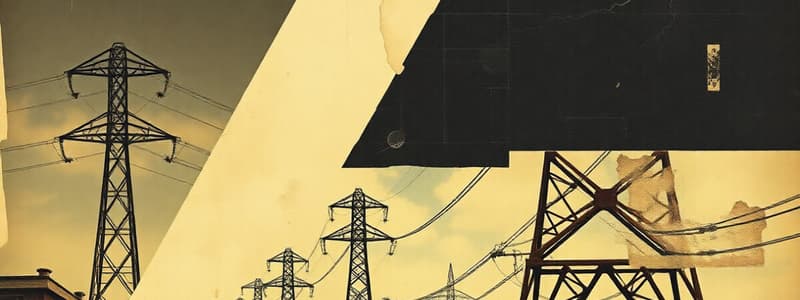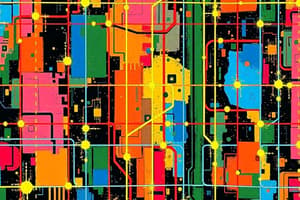Podcast
Questions and Answers
What is one of the main purposes of grid code technical requirements?
What is one of the main purposes of grid code technical requirements?
- To provide financial assistance for grid operators
- To limit the types of electrical equipment used in the grid
- To govern the operation, connection, and behavior of electrical generation and consumption equipment (correct)
- To ensure aesthetics of electrical equipment
Which aspect is NOT typically covered by grid code technical requirements?
Which aspect is NOT typically covered by grid code technical requirements?
- Regulatory Financing (correct)
- Safety and Protection
- Operational Requirements
- Connection Requirements
What is meant by 'dispatchability' in the context of grid operation and control?
What is meant by 'dispatchability' in the context of grid operation and control?
- The controllability and responsiveness of generation sources to grid demands (correct)
- The ability to generate power from renewable sources only
- The financial dispatch of resources for grid management
- The permanence of energy output from a source
Which requirement helps maintain power quality in the grid?
Which requirement helps maintain power quality in the grid?
Which of the following is a component of grid support services?
Which of the following is a component of grid support services?
What does protection coordination ensure in an electrical grid?
What does protection coordination ensure in an electrical grid?
Which decision-making aspect is captured by data and communication standards in grid management?
Which decision-making aspect is captured by data and communication standards in grid management?
What is the goal of the voltage levels stipulated in connection requirements?
What is the goal of the voltage levels stipulated in connection requirements?
What is the acceptable voltage range for equipment designed for a nominal voltage of 230V AC?
What is the acceptable voltage range for equipment designed for a nominal voltage of 230V AC?
What is the minimum frequency operating limit for equipment designed for a nominal frequency of 60 Hz?
What is the minimum frequency operating limit for equipment designed for a nominal frequency of 60 Hz?
Why is it important to adhere to voltage and frequency operating limits?
Why is it important to adhere to voltage and frequency operating limits?
What typically happens to solar PV systems during significant voltage dips?
What typically happens to solar PV systems during significant voltage dips?
Which characteristic allows wind turbines to tolerate short-term voltage dips?
Which characteristic allows wind turbines to tolerate short-term voltage dips?
What is a common manifestation of power quality issues?
What is a common manifestation of power quality issues?
Which phenomenon is characterized by a short-term increase in voltage levels?
Which phenomenon is characterized by a short-term increase in voltage levels?
What can frequency variations lead to when outside of acceptable limits?
What can frequency variations lead to when outside of acceptable limits?
What is a typical cause of harmonic distortion in power systems?
What is a typical cause of harmonic distortion in power systems?
What happens to wind turbines during a grid outage?
What happens to wind turbines during a grid outage?
What is one method used to mitigate power quality issues?
What is one method used to mitigate power quality issues?
What can cause voltage imbalances in three-phase systems?
What can cause voltage imbalances in three-phase systems?
Which technology is increasingly helping renewable energy systems provide ancillary services?
Which technology is increasingly helping renewable energy systems provide ancillary services?
How can power utilities manage power quality levels for consumers?
How can power utilities manage power quality levels for consumers?
What does fault ride-through (FRT) enable a wind farm to do during grid faults?
What does fault ride-through (FRT) enable a wind farm to do during grid faults?
What is the purpose of voltage ride-through (VRT) for wind farms?
What is the purpose of voltage ride-through (VRT) for wind farms?
Which of the following best describes real power regulation at wind farms?
Which of the following best describes real power regulation at wind farms?
What do voltage and frequency operating limits ensure for electrical equipment?
What do voltage and frequency operating limits ensure for electrical equipment?
What does low voltage ride-through (LVRT) require from wind farms?
What does low voltage ride-through (LVRT) require from wind farms?
During grid disturbances, how must wind farms respond to frequency deviations?
During grid disturbances, how must wind farms respond to frequency deviations?
What is a requirement for reactive power regulation in wind farms?
What is a requirement for reactive power regulation in wind farms?
What is one important function of testing and verification for wind farms relative to grid codes?
What is one important function of testing and verification for wind farms relative to grid codes?
Why is fault ride-through capability critical in wind farms?
Why is fault ride-through capability critical in wind farms?
What is typically indicated by the voltage operating limits for wind farms?
What is typically indicated by the voltage operating limits for wind farms?
What is high voltage ride-through (HVRT) meant to address?
What is high voltage ride-through (HVRT) meant to address?
What should operators of wind farms focus on to comply with grid code requirements?
What should operators of wind farms focus on to comply with grid code requirements?
Which variable may wind farms need to adjust in response to changes in grid conditions?
Which variable may wind farms need to adjust in response to changes in grid conditions?
What is the main advantage of hybrid solar PV and wind systems?
What is the main advantage of hybrid solar PV and wind systems?
Which countries are included in the Nordel cooperation?
Which countries are included in the Nordel cooperation?
What primary benefit do interconnected power systems provide?
What primary benefit do interconnected power systems provide?
What is a characteristic of isolated solar PV and wind systems?
What is a characteristic of isolated solar PV and wind systems?
Which region is exploring interconnections to harness solar power in desert areas?
Which region is exploring interconnections to harness solar power in desert areas?
What is a challenge faced by hybrid and isolated renewable energy systems?
What is a challenge faced by hybrid and isolated renewable energy systems?
Which is NOT a type of isolated operation for renewable energy?
Which is NOT a type of isolated operation for renewable energy?
Which major interconnected grid does not exist in North America?
Which major interconnected grid does not exist in North America?
What is one example of a hybrid renewable energy project?
What is one example of a hybrid renewable energy project?
What is the main purpose of Renewable Energy Zones (REZs) in Australia?
What is the main purpose of Renewable Energy Zones (REZs) in Australia?
Which of the following is a characteristic of hybrid systems?
Which of the following is a characteristic of hybrid systems?
What is a common type of isolated renewable energy system?
What is a common type of isolated renewable energy system?
What represents a benefit of operating hybrid systems?
What represents a benefit of operating hybrid systems?
What does the European Network of Transmission System Operators for Electricity (ENTSO-E) focus on?
What does the European Network of Transmission System Operators for Electricity (ENTSO-E) focus on?
What key factor can influence the success of power system interconnections?
What key factor can influence the success of power system interconnections?
Flashcards are hidden until you start studying
Study Notes
Grid Code Technical Requirements
- Grid codes provide safety, reliability, and efficiency for the electricity grid
- They apply to both transmission and distribution networks
- They cover connection, operational, safety, grid control and compliance aspects
Connection Requirements
- Specify voltage levels for generators and consumers
- Define grid frequency requirements including tolerances
- Set standards for compatible and safe physical connections
Operational Requirements
- Maintain power quality within acceptable limits, including voltage regulation, harmonic distortion, flicker, and transient responses
- Require equipment to contribute to grid stability, including reactive power support, frequency response and voltage control compliance
- Specify standards for ancillary services like frequency regulation, voltage support and black start
Safety and Protection
- Require coordination of protection systems for selective tripping and isolation of faulty equipment
- Implement safety standards against electrical hazards, including grounding and preventing islanding
Grid Operation and Control
- Require generation source controllability and dispatchability, including ramp rates, output flexibility, and grid operator command response
- Set standards for data exchange and communication between grid operators and equipment for grid monitoring, control and optimization
Grid Code Compliance and Testing
- Require verification and certification of compliance before equipment connection or commissioning
- Define test requirements for different operating conditions to demonstrate compliance
Evolving Requirements
- Adapt to accommodate the integration of renewable energy sources, including grid stability requirements during variable generation and considerations for energy storage systems
- Integrate smart grid technologies and advanced metering infrastructure (AMI) requirements to enhance grid flexibility and efficiency
Fault Ride-Through for Wind Farms
- Wind farms must stay connected during grid faults to maintain grid stability and reliability
- Key aspects include voltage ride-through, frequency ride-through, and duration requirements
Voltage and Frequency Operating Limits
- Defines the safe and efficient operating ranges for electrical equipment
- Includes nominal, minimum and maximum limits for both voltage and frequency
- Ensure equipment safety, performance, longevity, and compliance with regulations
Solar PV and Wind Farm Behavior During Grid Disturbances
- Solar PV systems generally disconnect from the grid during significant voltage dips
- They are not primarily designed to actively stabilize grid frequency but some inverters have limited capabilities
- Wind turbines can tolerate and continue to operate during short-term voltage dips, providing some frequency support
Power Quality Issues
- Deviation from ideal electrical supplies can disrupt normal operation
- Include voltage sag, swell, interruption and imbalance
- Harmonic distortion, transient voltages and frequency variations can be caused by faults, lightning and non-linear loads
- Mitigations include power quality monitoring, surge protectors, voltage regulators and harmonic filters
Power System Interconnection Experiences
- Interconnections are crucial for reliable and efficient electricity supply across regions and countries
- Examples include the European Union (EU), Nordic countries, North America, Australia, China, South America, and Middle East and North Africa (MENA)
- Challenges include regulatory differences, technical integration, and geopolitical factors
Hybrid and Isolated Operations of Solar PV and Wind Systems
- Hybrid systems combine solar PV and wind turbines to maximize energy output and complement each other’s intermittency
- Benefits include enhanced reliability, optimized use of resources, and grid support
- Isolated systems operate independently from the main grid in remote locations
- Types include remote microgrids and stand-alone systems
- Benefits include energy access, resilience and cost savings
- Challenges include intermittency, system design and grid integration
Studying That Suits You
Use AI to generate personalized quizzes and flashcards to suit your learning preferences.





